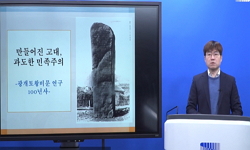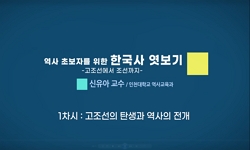吉林省 吉林市 龍潭區 吳拉街鎭 楊屯村에 위치한 대해맹 상층 유적은 1971년의 시굴조사와 1979·1980년의 발굴조사를 통해 청동기-부여-발해에 이르는 중층유적임이 확인되었다. 특히 상층의 ...
http://chineseinput.net/에서 pinyin(병음)방식으로 중국어를 변환할 수 있습니다.
변환된 중국어를 복사하여 사용하시면 됩니다.
- 中文 을 입력하시려면 zhongwen을 입력하시고 space를누르시면됩니다.
- 北京 을 입력하시려면 beijing을 입력하시고 space를 누르시면 됩니다.
부가정보
국문 초록 (Abstract)
대해맹 상층 유적은 출토된 유물의 교차연대, 유적의 층위와 유구 간 중복 관계 등으로 미루어 7세기 중반 이전부터 8세기 후반 이후까지 장기간에 걸쳐 고분군이 조성되었음을 파악할 수 있었다. 한편 단위 유구 내에서 복수의 피장자가 확인되어 주목되는데, 토광묘라는 유구의 특성을 염두에 둔다면 피장자의 해부학적 연속성이 유지된 1차장과 육탈 후 집골 또는 해부학적 연속성을 염두에 두고 재배치된 2차장이 동시에 이루어졌을 가능성을 피력하였다.
따라서 대해맹 상층 유적의 연대와 매장 행위를 염두에 둔다면 시간적으로 고구려 말기~발해에 걸친 기간 동안 유적을 점유하던 속말말갈 집단의 문화적 성격을 추론해 보는데 또 하나의 지침이 될 수 있다는 데서 그 의미를 찾을 수 있다.
吉林省 吉林市 龍潭區 吳拉街鎭 楊屯村에 위치한 대해맹 상층 유적은 1971년의 시굴조사와 1979·1980년의 발굴조사를 통해 청동기-부여-발해에 이르는 중층유적임이 확인되었다. 특히 상층의 발해유적은 대부분 토광묘로써 다양한 유물이 출토되었고, 다수의 유구에서 인골이 확인되어 피장자들의 매장 행위를 추론하는 데 큰 도움이 된다.
대해맹 상층 유적은 출토된 유물의 교차연대, 유적의 층위와 유구 간 중복 관계 등으로 미루어 7세기 중반 이전부터 8세기 후반 이후까지 장기간에 걸쳐 고분군이 조성되었음을 파악할 수 있었다. 한편 단위 유구 내에서 복수의 피장자가 확인되어 주목되는데, 토광묘라는 유구의 특성을 염두에 둔다면 피장자의 해부학적 연속성이 유지된 1차장과 육탈 후 집골 또는 해부학적 연속성을 염두에 두고 재배치된 2차장이 동시에 이루어졌을 가능성을 피력하였다.
따라서 대해맹 상층 유적의 연대와 매장 행위를 염두에 둔다면 시간적으로 고구려 말기~발해에 걸친 기간 동안 유적을 점유하던 속말말갈 집단의 문화적 성격을 추론해 보는데 또 하나의 지침이 될 수 있다는 데서 그 의미를 찾을 수 있다.
다국어 초록 (Multilingual Abstract)
Based on the cross-dating and artifacts from the upper layer site of Dahaimeng, and the overlapping relationship between the layers of the site and the features, it was determined that tumuli were built over a long period of time from before the mid-7th century to after the late 8th century.
Meanwhile, it is worth noting that multiple buried people were identified within the features. Considering the characteristics of the features as earthen tombs, it suggests that the primary burial method, which maintained the anatomical continuity of the buried people, and the secondary burial, which was rearranged with bone collection or anatomical continuity in mind after only bones remained, may have been carried out simultaneously.
Therefore, this site holds significance as it serves as a reference to infer the cultural nature of the Sogmal Malgal tribe, who occupied the site during the late Goguryeo period to the Balhae period, based on the chronology and burial practices of the upper layer site of Dahaimeng.
The upper layer site of Dahaimeng, located in Yangtun Village, Wulajie Town, Longtan District, Jilin City, Jilin Province, China, was initially excavated in 1971. Through subsequent excavations in 1979 and 1980, it was confirmed to be a middle layer s...
The upper layer site of Dahaimeng, located in Yangtun Village, Wulajie Town, Longtan District, Jilin City, Jilin Province, China, was initially excavated in 1971. Through subsequent excavations in 1979 and 1980, it was confirmed to be a middle layer site, which covers the Bronze Age, Buyeo, and Balhae,. Most importantly, Balhae remains in the upper layer are mostly earthen tombs, where various artifacts have been excavated. Human bones have been identified in many features, which greatly help us understand the burial practices of that time.
Based on the cross-dating and artifacts from the upper layer site of Dahaimeng, and the overlapping relationship between the layers of the site and the features, it was determined that tumuli were built over a long period of time from before the mid-7th century to after the late 8th century.
Meanwhile, it is worth noting that multiple buried people were identified within the features. Considering the characteristics of the features as earthen tombs, it suggests that the primary burial method, which maintained the anatomical continuity of the buried people, and the secondary burial, which was rearranged with bone collection or anatomical continuity in mind after only bones remained, may have been carried out simultaneously.
Therefore, this site holds significance as it serves as a reference to infer the cultural nature of the Sogmal Malgal tribe, who occupied the site during the late Goguryeo period to the Balhae period, based on the chronology and burial practices of the upper layer site of Dahaimeng.
목차 (Table of Contents)
- Ⅰ. 머리말
- Ⅱ. 조사현황
- Ⅲ. 유적의 연대
- Ⅳ. 매장 행위 추론
- Ⅴ. 맺음말
- Ⅰ. 머리말
- Ⅱ. 조사현황
- Ⅲ. 유적의 연대
- Ⅳ. 매장 행위 추론
- Ⅴ. 맺음말
동일학술지(권/호) 다른 논문
-
- 한국상고사학회
- 편집부
- 2024
- KCI등재
-
- 한국상고사학회
- 손준호(Joon-ho Son)
- 2024
- KCI등재
-
- 한국상고사학회
- 강승호(Seungho Kang)
- 2024
- KCI등재
-
- 한국상고사학회
- 원해선(Haeseon One)
- 2024
- KCI등재





 스콜라
스콜라






